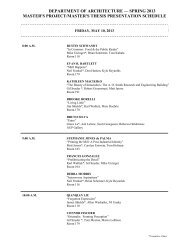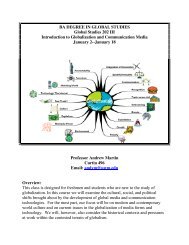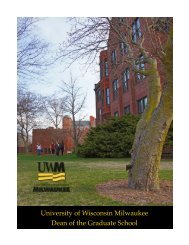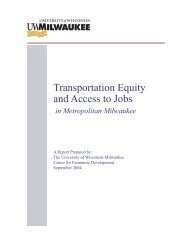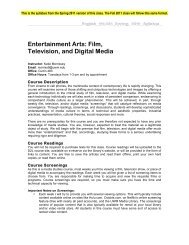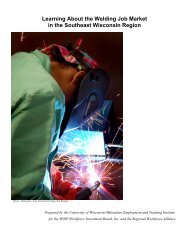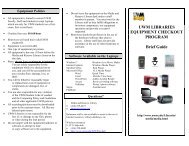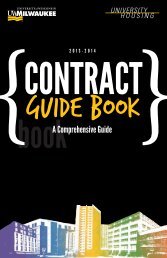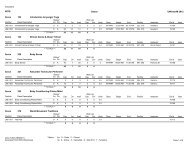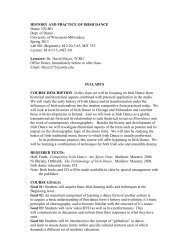Department of Africologycontinued from page 2Celebrating 40 yearsProfessor Patrick Bellegarde-Smith atthe Department of Africology’s 40thAnniversary Celebration.Today, in yet another historic yearfor the nation, <strong>UW</strong>M’s Department ofAfricology marks its 40th anniversarywith the creation of a PhD program.This expansion places <strong>UW</strong>M among anelite group of only eight institutions,including Temple, the University ofCalifornia at Berkeley, Yale, andHarvard, that offer such a doctoralprogram. Set to begin in the fall of2009, the program is expected to attractapplicants from all over the world andwill involve substantial cross-disciplinarycollaboration. It will be organizedaround three areas of focus:• Political Economy and Public Policy• Culture and Society: Africa and theAfrican Diaspora• A concentration outside the departmentin the student’s area of interestJoyce Kirk, associate professor andchair of the Africology Department,In 2009, <strong>UW</strong>M willbecome one of onlyeight institutionsoffering a doctoralprogram in Africology.notes that the Board of Regents’approval of the doctoral degree “sendsa strong signal to Wisconsin and<strong>Milwaukee</strong> residents that this programis an institutional priority.”Since its inception, theDepartment of Africology has taughtmore than 60,000 students. Itsgraduates have gone on to becomephysicians, teachers, lawyers, businessprofessionals, and elected officials.Academic Opportunity Centercontinued from previous pageOne aspect of the program that’sremained consistent over the years isits method of comprehensive evaluationfor admission, which Russell saysis gaining traction on a system-widelevel. “We have always looked at othercriteria than cognitive, quantitativeinformation,” she explains. Test scores,examples of leadership, communityinvolvement, high school extra curricularactivities, and work experienceare all taken into account whenmeasuring a student’s potential foracademic success. Russell adds thatthe 21st century has delivered a uniqueset of obstacles for the program, “It’s adifferent age. Students are just differentand it’s unfortunate that someonetold them along the way, ‘you’re doingvery well.’ So here they are…in somecases not writing a clear, declarativesentence but can text message out ofthis world. Critical thinking is seriouslylacking,” she says.Looking towards the next 40 years,Russell believes that Spaights’ initialidea of building a community within auniversity remains the core of howstudents become successful. “It wasalmost a one-stop shop,” she claims.“Believe it or not, we’re getting backto that.”Jimmy Johnstone, senior advisor4 Fall <strong>2008</strong>/Myriad
Full-Ride Scholarships Availablefor Incoming First-Year StudentsBy Beth StaffordHigh school seniors can againapply for full-ride scholarshipsto <strong>UW</strong>M through a programlaunched in 2007. The Chancellor’sScholarship for Diversity and Leadershipand the Academic AchievementLeadership Award were created by<strong>UW</strong>M to complement the scholarshipsand student aid assistance alreadyoffered.This fall, the first group of studentsreceiving these awards began theirstudies at <strong>UW</strong>M.“I've met many of the young menand women receiving these scholarships,”says Chancellor Carlos E.Santiago, “and am confident we haveselected individuals who can be bothacademic leaders at <strong>UW</strong>–<strong>Milwaukee</strong>and community leaders in the yearsthat follow.”Students with outstanding academicachievement who are interestedin a broad range of experiences andactivities designed to foster leadershipdevelopment and personal growth areencouraged to apply. The two scholarshipawards are applicable to any areaof study at <strong>UW</strong>M.Chancellor’s Scholarship forDiversity and LeadershipThese renewable scholarships includetuition, residence hall (includingmeals), books and miscellaneousexpenses, estimated at more than$20,000 for the 2009-10 academic year.Additional full- and partial-tuitionscholarships also are available. Thescholarships are available to studentswho are historically under representedin higher education and demonstrateoutstanding academic achievementand leadership.continued on page 12Winners of Chancellor’s Scholarshipfor Diversity and LeadershipBy Beth StaffordFollowing is a brief profile on each of the Chancellor’s Scholarship winners. Congratulations tothese outstanding students who are currently enrolled as new freshmen at <strong>UW</strong>M!Alyssa Galaviz (WAUKESHA, WI)WAUKESHA WEST HIGH SCHOOLCURRENT PLAN: UNDECIDEDBesides her leadership roles in theclassroom and in community serviceorganizations, Alyssa was also thecaptain of her track and field team.“As a captain, my determination andmy own desire to become the bestguided me to push others on myteam to reach one common goal.”She agrees with Tolstoy that “the only certain happiness inlife is to live for others,” and she hopes to “improve as manypeople’s lives as I can.”Alyssa’s mother, father, and brother all graduated from<strong>UW</strong>M. “I knew that by choosing <strong>UW</strong>M, I was not onlychoosing a high quality education, but also a positive forcein the community.” And she looks forward to attending theuniversity “because it has such a diverse body of studentsand activities.”Mary Ghaly (WAUKESHA, WI)WAUKESHA NORTH HIGH SCHOOLCURRENT PLAN: INDUSTRIAL ENGINEERINGFor Mary, it is very important tothink for herself and not just “followthe crowd.” She credits her two yearsof working at an after-school job withfacilitating her work ethic and allthat entails—integrity, cooperation,concern for others, industry andresponsibility. “These are all vitalcharacteristics of leadership,” she says. In addition, herreligious and spiritual beliefs are very important to her andhave helped her follow her own principles.Mary appreciates the fact that <strong>UW</strong>M assigns first-yearstudents a mentor and provides other support to helpstudents succeed. For her, the scholarship means theopportunity to be independent, while having the time to“give back” through the many volunteering opportunitiesavailable on campus.continued on next pageFall <strong>2008</strong>/Myriad 5



